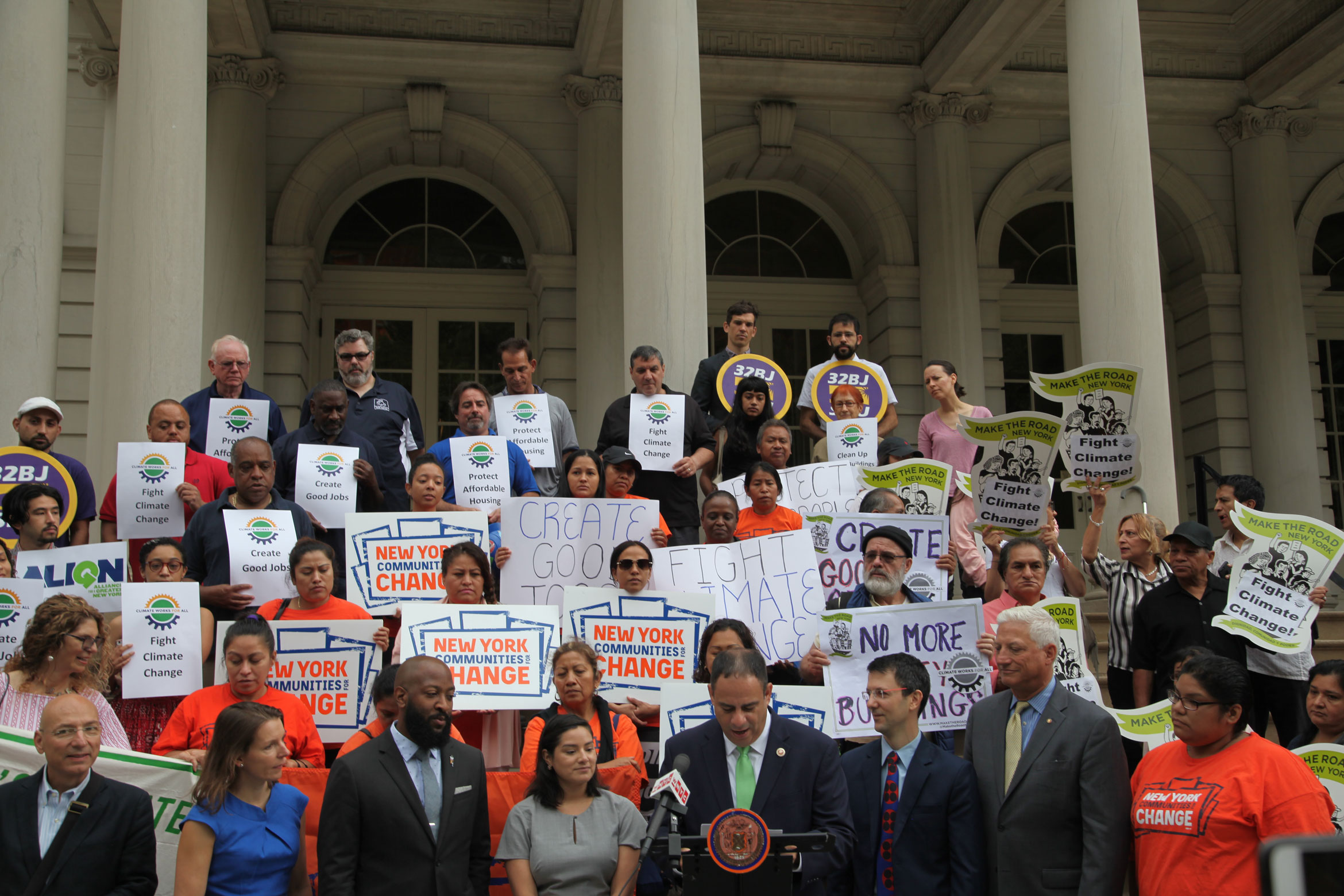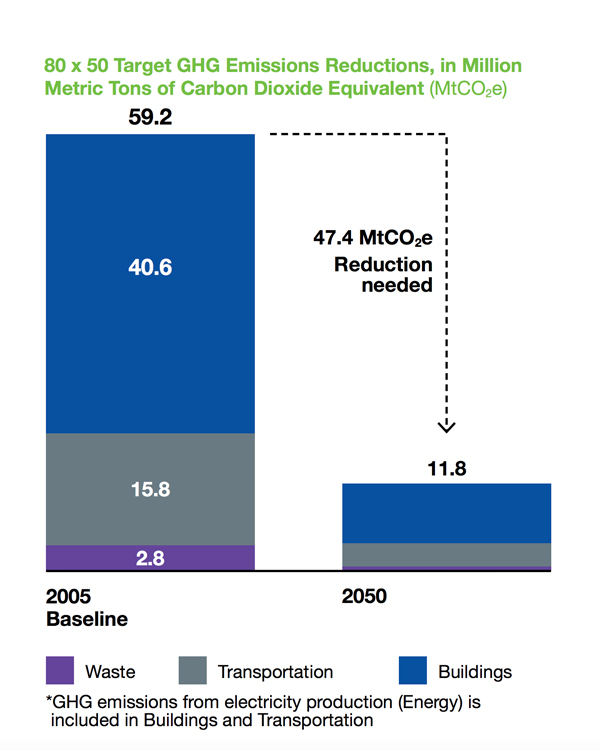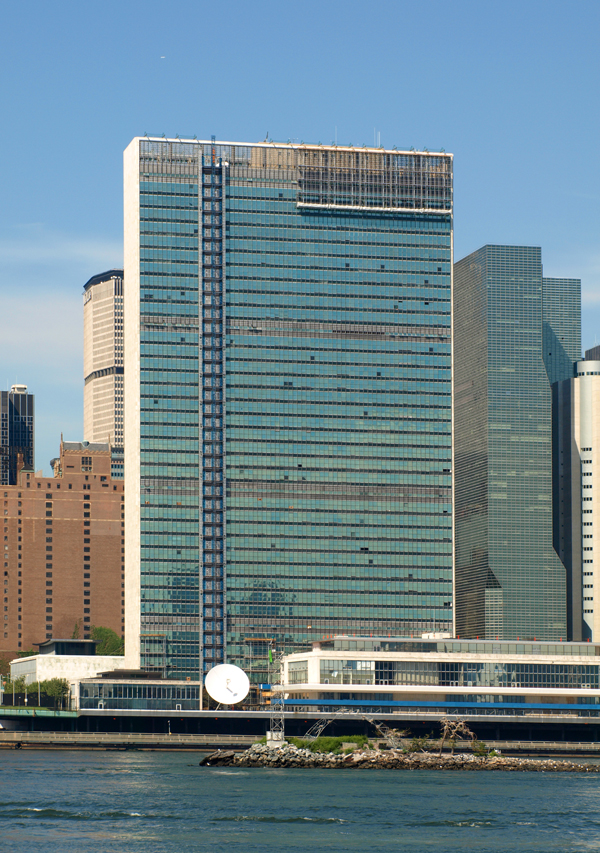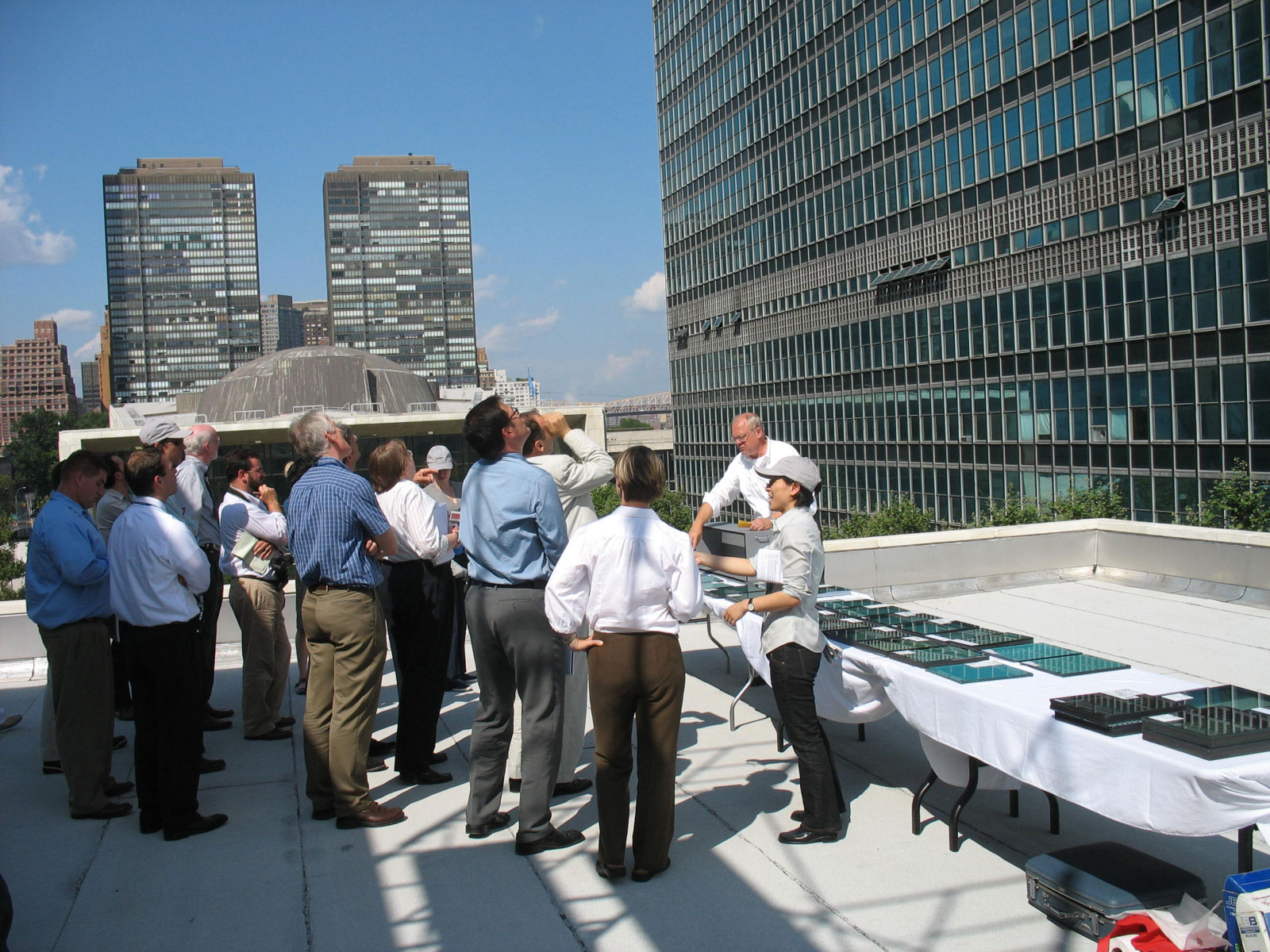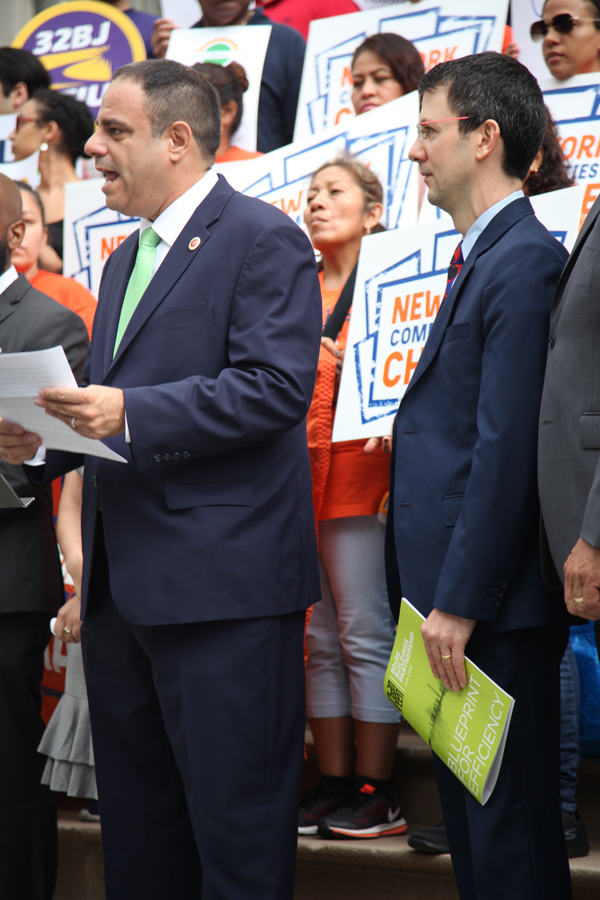People Movers
Community organizers give a window into the city they want and the work they’re doing to get there.
We are celebrating 15 years — and counting — of stories that are deeply researched and deeply felt, that build a historical record of what the city has been.
Not cars and trucks but large buildings — skyscrapers, hospitals, and apartment blocks — are the worst offenders when it comes to New York City’s greenhouse gas emissions. In 2050, the looming deadline to reduce the city’s emissions by 80 percent or face chaotic climate consequences, most of the city’s large buildings, with their inefficient heating, cooling, and lighting systems, will still be standing. Realistically, greening New York City doesn’t mean building a gleaming metropolis of tomorrow, but retrofitting the buildings that are already here. Changing light bulbs and heating systems, re-insulating walls erected a hundred years ago, and eventually heating and powering existing buildings with renewable energy sources are essential steps. But retrofitting on a large scale has also proved a nearly impossible task. Voluntary retrofits are slow to take off; meanwhile, any legislation making retrofits mandatory would have to unite stakeholders who usually regard one another as antagonists, not partners. Fortunately, the Urban Green Council was perfectly positioned to provide just this kind of highly technical diplomacy. As the law to clean up big buildings finally takes shape, Amy Howden-Chapman looks back on the process to better understand: In desperate times, how can we build unlikely alliances?
New York City has a dirty buildings problem. Vast amounts of electricity, gas, and oil are wasted in the heating, cooling, lighting, and powering of the city’s large buildings, which account for 67 percent of the city’s overall greenhouse gas emissions. In 2050, roughly 90 percent of New York’s current buildings are expected to still be in use: apartment buildings with ancient boilers, glass-walled office buildings with ineffective cooling systems, or poorly insulated warehouses with windows rattling in their frames. To meet the 2050 deadline for an 80 percent emissions reduction, and avoid major climate destabilization and the associated disruption of our cities, these buildings need to be fixed, and fast; designing new buildings to comply with stringent energy codes or passive-house ideals is not enough.
So how can buildings become cleaner and more energy efficient? The answer lies in retrofits to ensure energy circulates through a structure as efficiently as possible. Altering or replacing existing building elements can reduce the amount of energy used in a building’s lighting, heating, and electrical systems, and by extension, the greenhouse gases emitted in the course of supplying those systems. But retrofitting a building can do more than reduce the carbon footprint. It can improve local air quality, cut an owner’s operating costs and a tenant’s utility bills, improve the quality of life for residents (clanging pipes be gone!), and increase the overall value of a property. Plus, the process of carrying out retrofits could create thousands of jobs.
What is New York City waiting for? The short answer is money; the long answer is leadership. While some building owners have implemented energy efficiency retrofits voluntarily, the cost of retrofitting, along with uncertainty about what standards the city might require in the future — not to mention plain old inertia — have meant that the overall number of retrofits remains far below what is needed to meet the city’s reduction goals.
Retrofitting goes beyond changing the lightbulbs. Building owners may need to upgrade ventilation systems, install insulation around pipes and behind radiators, or tune and continually maintain boilers. Retrofitting also often entails insulating walls and ceilings and upgrading windows to eliminate gaps where heat escapes in winter and enters in summer. In a large building, even these piecemeal interventions are hardly tinkering: In 2009, retrofits to the Empire State Building, including upgrading each of the 6,514 windows to double pane, rang in at a cool $4.6 million.
Complete retrofits can be expensive and complex. All told, an optimal retrofit can cost as much as twelve percent of a property’s current market value. Thanks to the price tag, the number of voluntary energy efficiency retrofits throughout New York City to date has been limited. While some of the city’s universities, hospitals, commercial properties and residential property management firms have proven willing to act on their own, the current pledges account for only nine percent of building square footage citywide. The remaining 90 percent of the city is now the focus, and large buildings — those over 25,000 square feet — are key.
For over a decade, a growing coalition of progressive and environmental groups have tried to negotiate with the real estate industry, but have made little progress. They argue that if building owners won’t clean up their properties of their own accord, the City Council must pass legislation to make retrofits mandatory. But landlords won’t countenance a law that requires them to spend major sums to improve their building without mechanisms to help pay for the work. Further, environmental and social justice groups stipulate that any retrofit law must include protections for low-income New Yorkers against the imposition of rent hikes to cover the costs of retrofits.
With so many stakeholders and so much money involved, and when every New Yorker stands to be affected by a mandatory retrofit law, the ratio of talk to action over the years comes as no surprise. But legislation is finally in the works, and all sides are apparently close to agreement. How was consensus finally achieved?
In late September 2017, Mayor Bill de Blasio announced “the first ever city-wide mandate for building retrofits,” focused on 14,500 “worst offenders.” Tellingly, no members of the real estate industry were present at the press conference, and there was a noticeable absence of progressive environmental groups who had been working behind scenes on the issue for years. More tellingly still, no members of the City Council, who would ultimately have to draft and pass any legislation, came out in support. When asked about the Mayor’s plan, council member Costa Constantinides, who serves as chair of the Council’s Environmental Protection Committee, commented, “One partner in the dance has decided to dance without us.” The proposal went nowhere.
Earlier this summer, Constantinides, wearing a green tie, took to a podium in front of New York City Hall. He had recently declared that 2019 would be the “year of the retrofit,” and for once the proclamation suggested ambition and possibility, rather than wishful thinking. On the steps behind him, representatives from environmental and community groups held signs that read, “Fight Climate Change,” “Protect Affordable Housing,” and “Clean Up #Dirty Buildings.” Spokespeople from New York Communities for Change (NYCC) and the Working Families Party flanked Constantinides. Crucially, representatives from the real estate industry also stood by his side.
There was still no law to hold aloft, but Constantinides had called the conference to publicly celebrate a preliminary framework on which future legislation would be built.
After earlier attempts stalled out, lawmakers had realized that a foundation of consensus between traditionally opposed groups — tenant advocates and building owners, green NGOs and progressive activists, real estate and council members — would be needed. Urban Green Council (UGC), a not-for-profit group dedicated to developing climate solutions in the built environment, stepped forward and volunteered to broker an agreement.
UGC has long been offering technical guidance to help develop energy efficiency legislation in New York City. They helped the city draft rules governing the Green Greater Buildings Plan, a Bloomberg-era initiative that requires large buildings to make benchmark measurements of energy and water consumption, and to fix any broken or ill-functioning equipment identified during the process. As leader of the Green Codes Task Force, a plan to green the city’s building and constructions codes, UGC had experience bringing together those groups that would have a stake in future retrofit legislation.
Where similar efforts had failed before, UGC was able to foster productive discussion between groups more practiced at vehemently disagreeing with one another. “Unlike a lot of us, Urban Green is close enough to real estate to get them to the table, and at the same time they have enough technical credibility and political savvy that, it appears, real estate will listen,” said Stephan Edel, Director of the New York Working Families Project, which has been advocating for action on this issue for years. “UGC did a tremendous job of shepherding folks and putting people in a collaborative process where there was very good information and good decision making,” says Pete Sikora, Climate and Inequality Campaigns Director, for New York Communities for Change, “not to mention a decent amount of cordial shuttle diplomacy.”
The resulting Blueprint for Energy Efficiency is a framework document that sets out collectively defined goals for energy efficiency, and how large buildings can achieve them. The Blueprint marks a recent victory in a very long process. It developed over the course of eight months, through 1,300 hours of meetings held between 70 representatives from fields as diverse as real estate, labor, energy efficiency, and government.
Urban Green asked all parties to consider very broadly the variety of issues at stake, and then called on them to generate multiple ideas about ways in which those issues could be solved. “We challenged participants to evaluate many options before settling on a position,” Russell Unger, Chief Strategy Officer of the Urban Green Council said. The devil was in the details, and the UGC’s uber-specific expertise was important for reconciling various, very technical objections while keeping the larger goal in mind.
One of the primary issues that UGC needed to solve was how to measure energy use in large buildings. The real estate industry fought previous legislation in part because goals were based on an Energy Use Intensity (EUI) metric which measures the total amount of energy and fossil fuels a building is consuming, but does not consider what type of building it is or what is occurring inside. For example, a data center or a hospital will have a much higher EUI rating than a warehouse. A spokesperson for the Real Estate Board of New York (REBNY), called EUI a “blunt metric” that penalized building density and failed to measure real energy efficiency. The Urban Green Council process looked closely at other possible metrics including the EPA’s Energy Star rating tool, which compares like buildings with like: schools with schools, data centers with data centers. However, even this risks penalizing buildings for the city’s relative density — a New York apartment building might rate poorly relative to a Los Angeles apartment, even if the New York City building has twice as many occupants per square foot. The Blueprint for Energy Efficiency ultimately proposed a “Made-in-NYC Metric” that accounted both for different uses and for contextual density.
It was only with every sector’s wants and needs fully understood that a new vision for energy efficiency legislation began to materialize. Solutions to one group’s problems often lay in another group’s capacities. For example, to assuage building owners worried about paying for energy efficiency retrofits, UGC located potential funding in tactics like shortening the heating season to no longer include the month of May. The cumulative savings to building owners could free up capital for retrofitting measures. Despite the long history of conflict between landlords and tenants, “there are a lot of interests that are not necessarily inconsistent with one or other,” Unger said.
For progressive groups, making sure the costs of retrofits are not passed on to tenants is critical, especially given that retrofits have the potential to pay for themselves twice over (both by saving building owners money on utilities over time and by increasing the overall value of a property). This would be particularly problematic in the case of buildings with rent-regulated units. Landlords recover the costs of whole building expenses (such as replacing a boiler) by increasing rents, invoking something called a Major Capital Improvement (MCI). These rent increases can push a unit out of regulation to become market-rate. The prospect of losing rent-regulated units from the city’s affordable housing stock because of MCIs triggered by retrofits is anathema to community organizations, housing advocates, and progressive environmental groups, who argue that environmental policy should reduce rather than exacerbate inequality. Yet these groups don’t want to lose the emissions reductions produced by eventually retrofitting properties with rent-regulated units, nor do they wish to stand in the way of quality-of-life benefits (such as quieter, better temperature-controlled housing and lower utility bills) retrofitting can bring to low-income New Yorkers. Until rent control law is amended at a state level, the Blueprint recommends that only “low-cost, energy-saving measures that don’t qualify as MCIs” are applied to buildings with rent-stabilized units.
Formulating a detailed plan that touches on every element of how energy efficiency legislation should be constructed, the UGC pushed the conversation forward. The question was no longer if legislation would be passed, but what kind.
Council Member Constantinides arrived at a recent meeting about the draft legislation fresh from the Mayor’s Office of Recovery and Resiliency, where he learned about the potential impact of sea level rise on his district in Queens. The possibility that half his district could soon be underwater had by all reports fired him up, renewing his commitment to making sure the year of the retrofit is just around the corner. Once UGC developed detailed consensus-driven solutions, progressive groups made a public case for the urgency of action. Under the banner of the environmental justice coalition Climate Works for All, representatives of these organizations met with individual council members to explain the intricacies of retrofitting, while also drumming up public support and delivering a letter signed by over a thousand community leaders urging City Council Speaker Corey Johnson to get legislation passed. On November 28, Constantinides, with Johnson and eight other city council members, introduced a bill to the City Council.
The benefits from successful retrofit legislation will be tangible for these organizations’ constituents: “Not just a decent paying job, but one you feel good about,” as Patrick Houston, climate and inequality campaigns organizer at NYCC, puts it. Houston sees NYCC’s work to help develop the framework and ultimately the legislation as making sure “the voices of low-income communities and communities of color become integrated into the future of climate solutions from the get-go.” Brett Thomason, a climate organizer at ALIGN and a lead facilitator of Climate Works for All, values the power of the legislation to develop a whole retrofit industry that both labor and environmental organizations, groups usually at loggerheads, can support. And the retrofit jobs that will be set in motion by this framework are so extensive that a market direction could be set for 30 years. “That’s almost someone’s entire career,” says Thomason.
In recent weeks, the UN Intergovernmental Panel on Climate Change and the National Climate Assessment have made clear that the window for action to avoid environmental catastrophe is closing. Overall support for a stringent energy efficiency bill is strong, but what comes next is still unknown. While the bill recently introduced to the city council doesn’t adopt all of the UGC’s recommendations, what seems to be locked in place is an understanding, on all sides, that a mandate is inevitable. Desperate times call for unlikely alliances, but building consensus, like building buildings, costs time and money. Everyone currently gathered around the drawing board is trying to avoid ending up back there in 2050. Worse would be a drawing board, and a city, already under water, beyond saving.
The views expressed here are those of the authors only and do not reflect the position of The Architectural League of New York.
Community organizers give a window into the city they want and the work they’re doing to get there.

